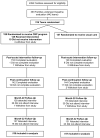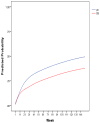Prevention of depression in at-risk adolescents: longer-term effects
- PMID: 24005242
- PMCID: PMC3978119
- DOI: 10.1001/jamapsychiatry.2013.295
Prevention of depression in at-risk adolescents: longer-term effects
Abstract
Importance: Adolescent offspring of depressed parents are at high risk for experiencing depressive disorders themselves.
Objective: To determine whether the positive effects of a group cognitive-behavioral prevention (CBP) program extended to longer-term (multiyear) follow-up.
Design: A 4-site randomized clinical trial with 33 months of follow-up was conducted. Recruitment of participants was from August 2003 through February 2006.
Setting: The study settings included a health maintenance organization, university medical centers, and a community mental health center.
Participants: Three hundred sixteen adolescent (aged 13-17 years) offspring of parents with current and/or prior depressive disorders; adolescents had histories of depression, current elevated depressive symptoms, or both but did not currently meet criteria for a depressive disorder.
Interventions: The CBP program consisted of 8 weekly 90-minute group sessions followed by 6 monthly continuation sessions. Adolescents were randomly assigned to either the CBP program or usual care (UC).
Main outcomes and measures: The primary outcome was a probable or definite episode of depression (Depression Symptom Rating score ≥4) for at least 2 weeks through the month 33 follow-up evaluation.
Results: Over the 33-month follow-up period, youths in the CBP condition had significantly fewer onsets of depressive episodes compared with those in UC. Parental depression at baseline significantly moderated the intervention effect. When parents were not depressed at intake, CBP was superior to UC (number needed to treat, 6), whereas when parents were actively depressed at baseline, average onset rates between CBP and UC were not significantly different. A 3-way interaction among intervention, baseline parental depression, and site indicated that the impact of parental depression on intervention effectiveness varied across sites.
Conclusions and relevance: The CBP program showed significant sustained effects compared with UC in preventing the onset of depressive episodes in at-risk youth over a nearly 3-year period. Important next steps will be to strengthen the CBP intervention to further enhance its preventive effects, improve intervention outcomes when parents are currently depressed, and conduct larger implementation trials to test the broader public health impact of the CBP program for preventing depression in youth.
Trial registration: clinicaltrials.gov Identifier: NCT00073671.
Conflict of interest statement
Dr. David Brent is a member of the Editorial Board of UpToDate and receives royalties from the Guilford Press. The other authors have no conflicts of interest to report.
Figures



References
-
- Pine DS, Cohen P, Gurley D, Brook J, Ma Y. The risk for early-adulthood anxiety and depressive disorders in adolescents with anxiety and depressive disorders. Archives of general psychiatry. 1998 Jan;55(1):56–64. - PubMed
-
- Kessler RC, McGonagle KA, Zhao S, Nelson CB, Hughes M, Eshleman S. Lifetime and 12-month prevalence of DSM-III-R psychiatric disorders in the United States. Archives of general psychiatry. 1994;51:8–18. - PubMed
-
- Lopez AD, Mathers CD, Ezzati M, Jamison DT, Murray CJ. Global and regional burden of disease and risk factors, 2001: systematic analysis of population health data. Lancet. 2006 May 27;367(9524):1747–1757. - PubMed
-
- Gibb SJ, Fergusson DM, Horwood LJ. Burden of psychiatric disorder in young adulthood and life outcomes at age 30. Br J Psychiatry. 2010 Aug;197:122–127. - PubMed
Publication types
MeSH terms
Associated data
Grants and funding
- UL1 TR000445/TR/NCATS NIH HHS/United States
- R01 MH64717/MH/NIMH NIH HHS/United States
- R01 MH064735/MH/NIMH NIH HHS/United States
- R01 MH64541/MH/NIMH NIH HHS/United States
- R01 MH064541/MH/NIMH NIH HHS/United States
- P30 HD015052/HD/NICHD NIH HHS/United States
- R01 MH064717/MH/NIMH NIH HHS/United States
- R01 MH64503/MH/NIMH NIH HHS/United States
- UL1 RR024975/RR/NCRR NIH HHS/United States
- UL1 RR024975-01/RR/NCRR NIH HHS/United States
- R01MH064735/MH/NIMH NIH HHS/United States
- 2 UL1 TR000445-06/TR/NCATS NIH HHS/United States
- R01 MH064503/MH/NIMH NIH HHS/United States
LinkOut - more resources
Full Text Sources
Other Literature Sources
Medical

